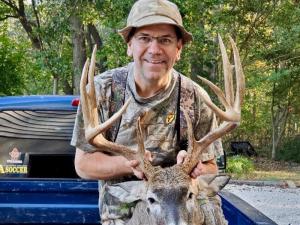Delaware hunters killed an estimated 7,068 white-tail deer during the 10-day shotgun season in late November. According to State Wildlife Administrator Rob Hossler, that number is about 6 percent higher than the shotgun harvest recorded in 2019.
“Hunters had good weather during the shotgun season this year,” he said. “Not a lot of heavy rain. Good conditions for hunting.”
Delaware’s shotgun deer season brings out the greatest number of hunters each year for any season. For deer hunting, the October muzzle-loader season is the second most popular in terms of participation and harvest. The antlerless deer season for shotgun hunters comes in third.
As of Nov. 22 this year, Hossler’s numbers show a total of 12,221 deer harvested, counting those taken with shotguns, traditional bows and crossbows, and muzzle-loader rifles.
“That’s a 2 percent decrease from this time last year, but considering last year’s total harvest of 17,000 deer was a record for Delaware, I think we’re doing pretty good this year.”
Hossler estimates Delaware’s total herd at 35,000 to 40,000 deer. “Our state deer herd is extremely healthy. We know that because we have the highest percentage of testing for diseases of any state in the country.”
There are three predominant reasons for Delaware’s healthy deer population. “We don’t have severe winters here, there is a lot of crop land that provides food, and we have lots of protected habitat. Hunting helps keep the herd healthy and stable. For the last seven or eight years, hunters have harvested an average of about 14,000 deer, half of them with shotguns. Last year was super high. I guess all the planets were aligned.”
Controlling crop damage
Delaware’s farmers not only gain income from renting out hunting rights, but depend on hunting to help counter crop damage inflicted by healthy deer herds. “Farmers will tell you crop damage is significant,” said Hossler. “That’s why we’ve provided a lot of tools to address the problem. We have programs allowing for extra harvest; we’ve opened Sunday for hunting; we now allow pistol-caliber rifles in certain seasons. All of these have been sought by hunters and farmers, and have been approved. Some have taken advantage of them and have reduced crop damage to acceptable levels. But it’s all about management – just like managing nutrients to keep costs down. If farmers estimate between $50,000 and $100,000 in crop damage each year, they could spend half of that on management and make out on the deal. For example, when they rent their lands, they can use extra harvesting limits to require hunters to take at least two does each year before they're allowed to shoot a buck. We’ve also hired an extension biologist to work directly with farmers. The pandemic delayed that program this year but we expect it to be in full swing next year.”
Hossler noted that the majority of Delaware farms are now rented out for deer hunting. “It’s pay to play,” he said. ”Hunting rights have become a commodity just like crops. It started in the Southeast and spread across the country.”
But there are also plenty of public lands available for hunting in Delaware. “There are more public lands now than ever before. A lot of Delaware’s Fish and Wildlife Division employees do well on public lands.” He said Fish and Wildlife’s 65,000 acres make it the single-largest landowner in Delaware. “Some say we shouldn’t be out there taking land out of private hands, but it’s not like we’re out looking for land to buy. People approach us to sell.”
Public lands are managed with funds generated by hunting license fees matched with federal conservation dollars. “We also have more and more nonhunter conservationists paying fees to park and use our wildlife areas. Birding groups want to contribute, and we have set up birding trails and observation platforms. We’re managing our wildlife resources for all the people of Delaware. For a state primarily agriculture and suburbia, I think we’re doing pretty well.”
Hossler’s perspective on deer hunting and wildlife management doesn’t just come from studying statistics. And it’s not just provincial pride that contributes to his sense that Delaware is a hidden gem in terms of its number and quality of deer. An avid deer hunter, Hossler has set a personal goal of killing a buck white-tail or other antlered animal in each of the nation’s 50 states. So far he has met that goal in 26 out of 27 states he’s tried.
‘It’s my way of seeing the country,” he said. “One deer stand at a time.”





















































